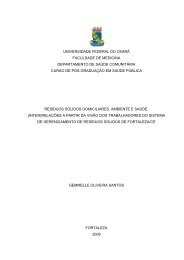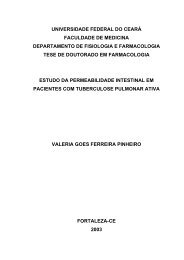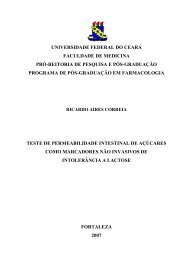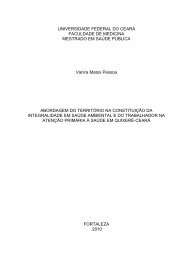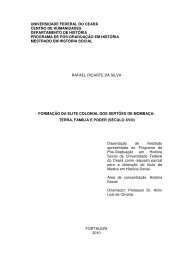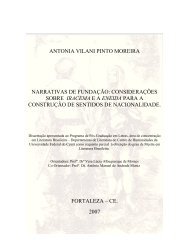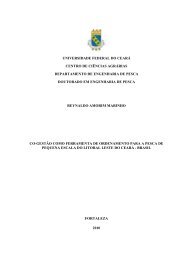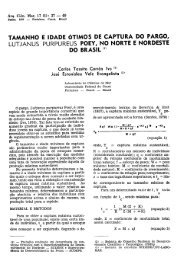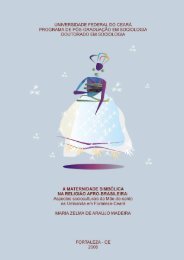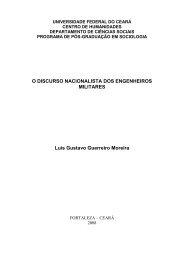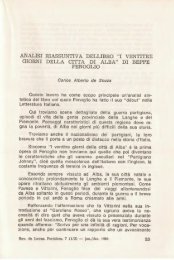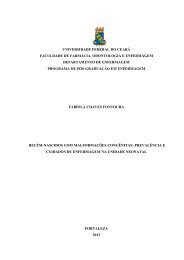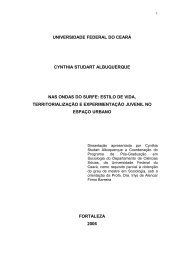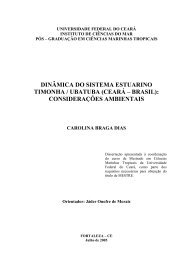Tungíase: doença negligenciada causando patologia grave
Tungíase: doença negligenciada causando patologia grave
Tungíase: doença negligenciada causando patologia grave
You also want an ePaper? Increase the reach of your titles
YUMPU automatically turns print PDFs into web optimized ePapers that Google loves.
Published by Maney Publishing (c) Liverpool School of Tropical Medicine<br />
barefoot to and on the beach were found to<br />
be significant risk factors for acquiring<br />
HrCLM (Tremblay et al., 2000). In a recent<br />
study on international travellers who had<br />
had vacations in north–eastern Brazil, all of<br />
those who had acquired HrCLM during<br />
their stay had visited beaches (Heukelbach<br />
et al., 2007). Thus, walking barefoot<br />
appears to be a universal risk factor, not<br />
only for the residents in endemic areas but<br />
also for visitors.<br />
Besides behavioural characteristics, several<br />
socio–economic variables were found to<br />
be risk factors for current/recent HrCLM in<br />
the present study. These were family<br />
income, lack of a toilet on the compound,<br />
and a floor consisting of sand or clay.<br />
Theoretically, in dwellings without a solid<br />
floor, transmission may occur inside, if<br />
animals defecate in the house or carry faecal<br />
material, attached to their paws, from outside<br />
into the interior. In practice, however,<br />
transmission within houses is probably<br />
unlikely, and the absence of a solid floor<br />
— together with a lack of basic sanitation<br />
and a low family income — simply indicates<br />
a household of relatively low economic<br />
status.<br />
Although dog or cat ownership were not<br />
identified as risk factors in Feliz Deserto,<br />
most dogs and cats in the community are<br />
free to roam where they want and this<br />
presumably means that owners are no more<br />
likely to come into contact with dog or cat<br />
faeces than those who do not own a dog or<br />
cat themselves.<br />
The present results have to be treated with<br />
a little caution because they are based only on<br />
a clinical diagnosis of current HrCLM and<br />
self-diagnosis of recent HrCLM, and other<br />
conditions that may cause creeping eruptions,<br />
such as scabies, gnathostomiasis, loiasis<br />
or dracunculiasis, may be mistaken for<br />
HrCLM (Caumes, 2006). The entire body of<br />
each subject was specifically checked for (and<br />
found free of) the typical clinical signs of<br />
scabies, however, and no gnathostomiasis,<br />
loiasis or dracunculiasis has ever been<br />
reported in the study area.<br />
CUTANEOUS LARVA MIGRANS IN BRAZIL 59<br />
The present data indicate that the most<br />
effective strategy for controlling HrCLM in<br />
Feliz Deserto (and probably many other<br />
rural communities in north–eastern Brazil)<br />
may be health education that is targetted at<br />
mothers and the elder girls who take care of<br />
their younger siblings. If infants, toddlers<br />
and small children were not allowed to play<br />
or sit on the ground outside their houses,<br />
most cases of HrCLM in the community<br />
could be avoided. Health education will<br />
probably fail to reduce the incidence in the<br />
second high-risk group: male adolescents.<br />
Most families in Feliz Deserto are too poor to<br />
afford shoes for all their children and, in any<br />
case, children with shoes still often walk and<br />
play soccer barefoot. In theory, the incidence<br />
of HrCLM could be greatly reduced by the<br />
regular treatment of all dogs and cats with<br />
anthelminthic drugs, but this is a difficult<br />
endeavour given the costs and the large<br />
number of stray animals to be found in<br />
Feliz Deserto and many other resource-poor<br />
communities. It may be much more feasible<br />
and effective to fence around public places<br />
used for soccer, to prevent the faecal contamination<br />
of the playing area. General<br />
improvements in houses and compounds,<br />
though cost-intensive, may also be beneficial<br />
and help protect children from HrCLM as<br />
well as other parasitic diseases, such as<br />
tungiasis (Muehlen et al., 2006).<br />
ACKNOWLEDGEMENTS. The authors thank<br />
the study community, the local healthcare<br />
workers, and E. de Barros Campelo Jr,<br />
A. Ferreira da Silva Filho, C. Calheiros,<br />
V. Soares and A. Dacal. This study was<br />
financially supported in part, by a grant<br />
from the Deutsche Akademie für Luft- und<br />
Reisemedizin. A.J. received a travel grant<br />
from the Deutsche Akademischer Austauschdienst<br />
(DAAD)–Coordenação de Aperfeiçoamento de<br />
Pessoal de Nível Superior (CAPES) PROBRAL<br />
programme for Brazilian–German academic<br />
exchange. L.A. received a PhD scholarship<br />
from CAPES. The data presented here form<br />
part of a medical thesis by A.J.



